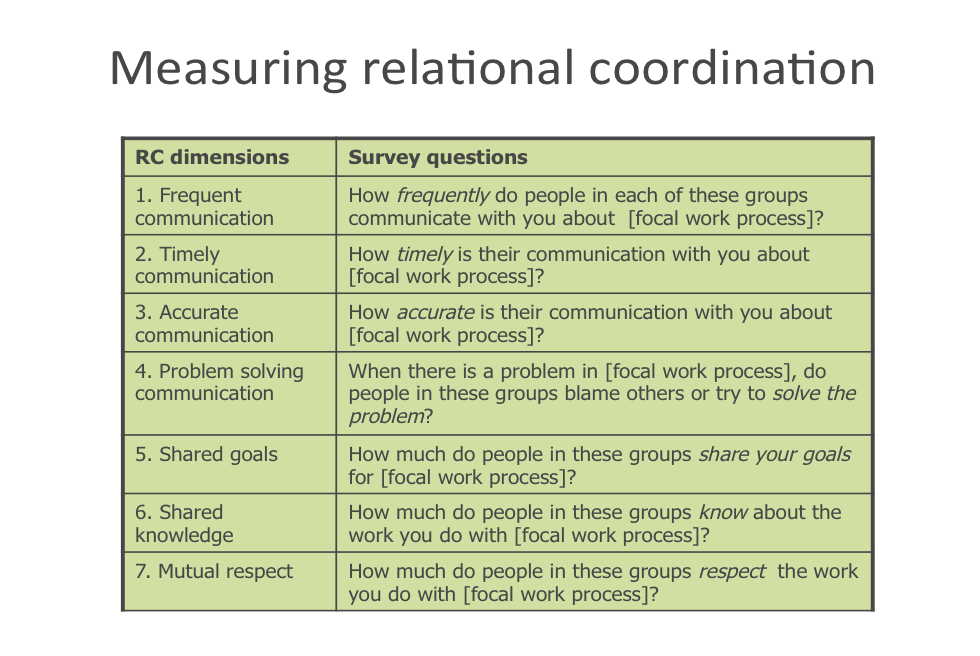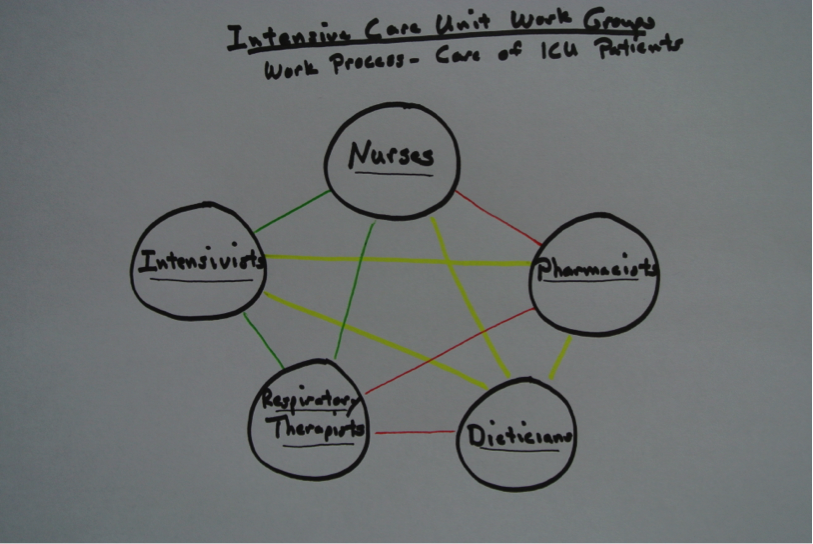{Liberating Structure in Development} Feedback on this LS
![]()
Relational Coordination Mapping (v1.4)
Illuminating and Improving How We Work Together
What is made possible? Illustrating how work is coordinated among individuals and groups evokes new ideas for improving social dynamics and, thus, outcomes. Research demonstrates that Relational Coordination – how people on teams communicate and relate – has a direct and powerful impact on quality, safety, efficiency and satisfaction among customers and staff.
Structural Elements – Min Specs
Structuring Invitation
- You are asked, “What new insights can we uncover about how we work together on our team on critical processes AND what new ideas can we generate for improving how we communicate and relate?”
Space & Materials
- Open space, colored markers and flip chart OR table/chairs and flip chart paper and markers for each small group
- Handout that shows 7 dimensions of Relational Coordination (RC) and RC questions
Participation
- Everybody connected to a team, or a good cross-section of members. There is no limit to number of participants
Configurations
- Small groups comprised of 5 to 7 people organized around a shared complex work process
Steps & Time Allocation
- [2] Short introduction to RC for all participants. Cover 7 dimensions of RC and highlight correlation of RC with quality, cost, efficiency and satisfaction outcomes. Participants can be asked to read an article about Relational Coordination in advance.
- [5] Small group members have short conversation about RC and resonance with their experiences on teams.
- [5] If not determined in advance, each group selects an important work process related to their team as a focus for RC Mapping. The work process should be one that demands a high degree of collaboration. Some examples are: care of patients in ICU; coordination of care across services like the ED and surgery; inpatient pain; functioning of management team; collaboration across a network of healthcare organizations.
- [5] Identify the key work groups (or individuals) that depend on each other to accomplish the work process
- [3] If you have identified more than 6 workgroups (or individuals) shift through the list and pare down to 6 or less workgroups (or individuals) OR combine closely related workgroups (or individuals) to reach the target of 6 or less.
- [10] 1-2-4-All. In a discussion informed by the 7 dimensions of RC, the group tries to develop a consensus on individual overall RC scores (low, moderate, high) that best represent the level of Relational Coordination between each workgroups or individuals. Display the levels of RC by drawing colored lines (red for low; yellow for moderate; and green for high) between each of the groups or individuals. See the example illustration below.
- [10] Using 1-2-4-All, discuss what the map reveals. In the deliberations consider what can be learned from relationships with high RC scores.
- [10] Referring to the 7 dimensions of RC, generate specific suggestions for improving RC. Invite each individual to commit to take one step (likely a 15% Solution) to improve Relational Coordination.
Total Time: 50 minutes
WHY? Purposes
- Helps everyone on a team gain deeper insights into team dynamics by drawing on RC dimensions and perspectives of colleagues
- Helps team members develop together specific strategies for improving patterns of communicating and relating
- Helps team members realize how deeply interdependent they are on one another
- Makes it a little easier to talk about the sensitive subject of everyday working relationships
Tips & Traps
- Invite everyone in the small groups to contribute
- Remember, the focus is on making sense of working relationships and patterns of communicating, not on individual behavior. This is not a performance evaluation or critique of individual behavior. Proceed with sensitivity.
- Maps show opportunities for improvement and highlight where RC is high, and thus good places to look for improvement inspiration
- Bells (e.g., tingsha) help you shift participants from step to step
- Visit the Relational Coordination Research Collaborative website - http://rcrc.brandeis.edu - or read “Impact of Relational Coordination on Quality of Care, Postoperative Pain and Functioning, and Length of Stay,” Gittell et al, Medical Care, 2000, vol 38, no. 8, in preparation for facilitating RC Mapping.
Riffs & Variations
- If you have a little more time and you wish to dive deeper into Relational Coordination, do two rounds of mapping. Devote the first to the communication aspects of RC (frequency, timeliness, accuracy, and problem-solving orientation) and the second to the 3 other dimensions (shared goals, shared knowledge and mutual respect).
- You can use this Liberating Structure to help a group decide whether to embark on a full-fledged RC survey and intervention process.
- You can use this Liberating Structure to help a group think through and plan a full-fledged RC survey and intervention process and explore such questions as: how should we engage staff to determine if there is interest in using RC; who should be involved; which work groups and/or individuals should be surveyed; how should we share and make sense of survey results; and how should staff be involved in creating plan to improve RC.
Collateral Material


Attribution: Developed by Curt Lindberg and inspired by Anthony Suchman and Jody Gittell from the Relational Coordination Research Collaborative.
